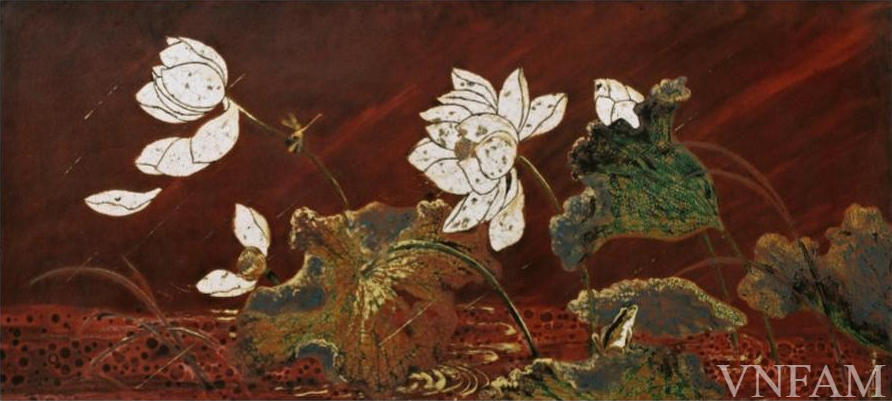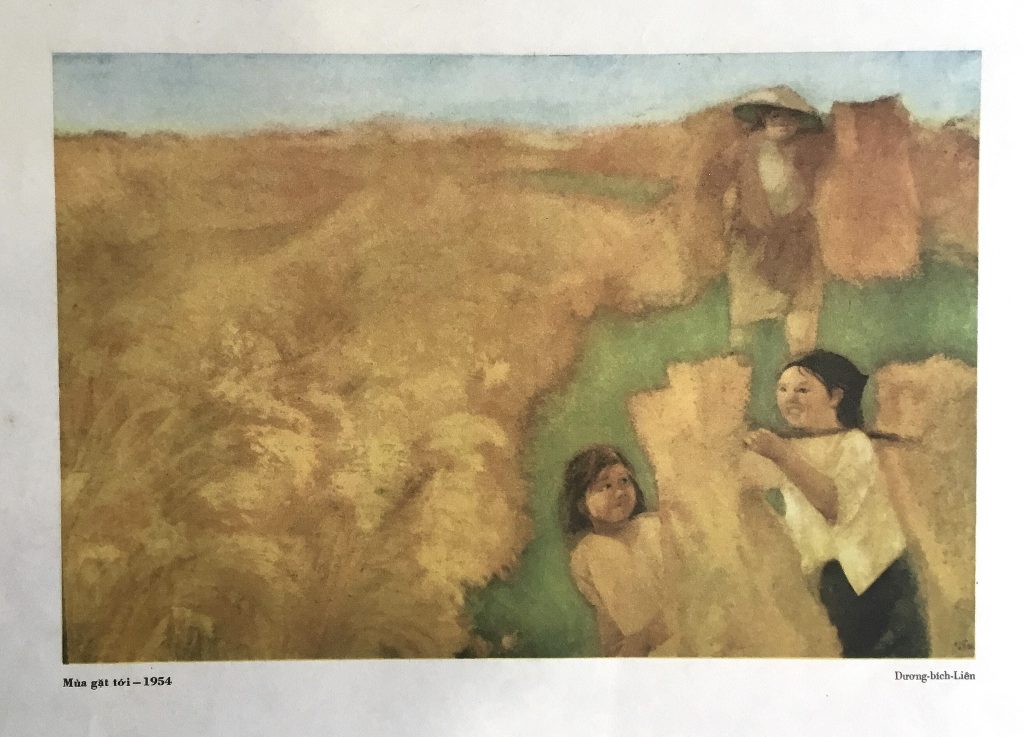
HOÀNG TÍCH CHÙ (1912-2003)
Elegant ladies in a garden
Lacquer, 1940, 130×122 cm
On October 8, 2023, at Metayer-auction, the rare lacquer painting titled Elegant ladies in a garden by artist Hoàng Tích Chù will be auctioned online on Interencheres platform in Art d’Asia auction.
Painting specifications are as follows:
Title of work: Elegant ladies in a garden
Year of creation: 1940
Medium: Lacquer
Dimensions: 130×122 cm
Estimate: 50,000 – 80,000 EUR
Deposit 10,000 EUR 24 hours before the auction
Since receiving information about this very rare painting, many collectors have disscussed with Viet Art View about the originality, rarity, and artistic value of the work. Even the optimal price that can be purchased was considered. With many perspectives, from historical value to artistic value, rarity, Viet Art View discuss some opinions from the following reference:
Along the line of history
In 1934, the An Nam Society for the Promotion of Fine Arts and Industry was established. As early as 1929, French professors realized that lacquer is a creative medium which was rich in artistic potential so they began to let students experiment with lacquer in painting with the support by lacquer artistan Đinh Văn Thành (1898-1977).
Professor Victor Tardieu wrote in a report: “This is a wonderful creative medium, worthy of becoming a national art form.”
After much research, exploration, and testing of techniques from students of many classes, with the support of lacquer artisan Đinh Văn Thành, in 1934, the lacquer workshop was established. In May 1938, the Lacquer Department officially became an independent academic department; which was loved by students.
The achievements of Vietnamese lacquer painting began to receive special attention as early as the 1930s. On the occasion of 1931 Paris Art Exhibition, Lê Phổ (1907-2001) presented the work Landscape of the North, lacquer screen (vermilion, black, gold, silver) created around 1929-1930. In 1932, Trần Quang Trân (1900-1969) created the screen Bamboo with water, six panels, 110×25 cm each; In 1938, Nguyễn Gia Trí (1908-1993) created Beside the lotus pond, 120×210 cm; 1939, he created two-paneled screen Landscape– Indian taro, 159×400 cm. In 1939, Lê Quốc Lộc (1918-1987) created Festival at the pagoda, 100.5×200 cm, when he was in his first year; In 1940, Phạm Hậu (1905-1994) created Summer wind, 67.7×149 cm…
With the above symbolic successes, it can be seen that the introduction of lacquer into painting is a breakthrough that makes Vietnamese lacquer painting become one of the special values for other painting forms in the world.
In 1938, when the Lacquer Department was established, student Hoàng Tích Chù (class of1936-1941) was in his second year. In the same class were Nguyễn Văn Tỵ (1917-1992), Nguyễn Tiến Chung (1914-1976).
In the same vibrant and exciting creative atmosphere, Elegant ladies in a garden was created by Hoàng Tích Chù in 1940, one year before he graduated in 1941. The painting is the inevitable result of a series of achievements that previous generations of artists had achieved.
Elegant ladies in a garden
At first glance, Elegant ladies in a garden shows a romantic, dreamy appearance following the favorite motif of that time. By the lake, three young women wearing modern áo dài, one sat absentmindedly resting, the other two were leisurely strolling. Lotus, cotton rose, grass, wildflowers, and a few beautiful flying butterflies bring the feeling of the coolness of nature.
There are three interesting details in this painting. The appearance of the little goat, the dove and the pair of cloth shoes embroidered with dragon and phoenix images seemed random at first; But maybe Hoàng Tích Chù did not arrange it so simply.
In Western culture, the image of the goat symbolizes fertility and prosperity. In Eastern culture, the goat is one animal of the lunar calendar, carrying philosophical and humanistic meanings. Hour of the Goat lasts from 13:00 to 15:00, which is the beginning of the afternoon, when people have just finished lunch, are peacefully resting and entering a new working session. Images of doves from East to West are symbols of life, peace and happiness.
Of the three young women wearing áo dài, the only one wearing a yellow áo dài with motif of cloud (often found in ancient folk decorative patterns) shaped along with shoes embroidered dragon and phoenix motifs. The remaining two young women wore modern shoes and áo dài with more modern patterns.
This East-West cultural interference was very consciously arranged by the artist. Harmony in the overall outfit, form to content; The sophistication expressed from the smallest details makes the work rich in symbol and nationality.
In the introduction to the work, it is written: This work evokes the collaboration between Hoàng Tích Chù and lacquer artisan Đinh Văn Lịch. Artisan Đinh Văn Lịch was born in 1916 (he is the younger brother of artisan Đinh Văn Thành, born in 1899) may not be reasonable. By 1941, Hoàng Tích Chù graduated and opened a workshop at Hàng Khoai street. In 1940, when making Elegant ladies in a garden, Hoàng Tích Chù was still studying at Indochina Fine Arts College. According to Mr Nguyễn Đình Đặng (grandson of artisan Đinh Văn Thành), Hoàng Tích Chù’s work have a relatively close connection with artisan Đinh Văn Thành (who was invited to support students in the lacquer department). So was it possible that artisan Đinh Văn Thành was the one who helped so that Hoàng Tích Chù (who had not graduated at that time) could complete the work?
The originality
When the painting was introduced on the auction house’s website, a few collectors discussed with Viet Art View about the originality of this work. In fact, when we have to view a work of art through photos, errors are possible. But basically, if you pay close attention to character shaping of Hoàng Tích Chù, you will notice his style in creating details for characters. Sometimes, just one identifying feature (throughout) will show that “what is shown on the face of the painting” is always the clearest proof of the “made in…” of a certain name. This is not difficult, just take the time to look carefully, observe carefully, and make comparisons with the artist’s works of the same period to find similar characteristics. From there, we can recognize the soul and the spirit in each artist’s personal mark.
Counterfeiters are often inexperienced. They can create a visual feeling of “seeing likeness”. But certainly any copying or “parody” is difficult to recreate the soul and the spirit of an individual artist. Experts, collectors, and art lovers are sophisticated and it is difficult to pass their professional eyes. Especially collectors and dealers, if not, they will lose a lot of money. When they are not confident enough, they will seek advice from experts (careful, skilled).
Therefore, if a rare, expensive painting is offered at public auction, it is an opportunity for all of us. If we can’t buy it, we can still look at it and discuss. And if it is not an original work, then very soon, there will be a good expert to warn us. And the number of underground experts is not small. Seeing that it is “annoying” they will definitely speak up. Because they don’t want real collectors to lose trust in a market full of dishonest profiteers. Collectors are not afraid of price fluctuations and liquidity. They just don’t want their love of art to be gradually eroded by a market that is not transparent and clean.
Estimate
Like other auctions, an attractive estimate is always part of the auction house’s calculations. With estimate ranging from 50,000 to 80,000 EUR for Elegant ladies in a garden, there will be many people bidding. But surely to the final price only a few people can afford. The price will be two hundred, three hundred or four hundred thousand euros, it’s entirely possible.
And that price is very worthy. The work is both profound, rare, valuable, and famous; Realistic, romantic, humanistic themes; Beautiful images, luxurious and noble characters; The painting surface is good (according to the photos). Early lacquer medium are also a big plus because of their historical value in the flow of Vietnamese lacquer painting.

LÊ PHỔ (1907-2001), Landscape of the North, circa 1929-1930
Lacquer screen (vermilion, black, gold, silver)

LÊ QUỐC LỘC (1918-1987), Festival at the pagoda, 1939, Lacquer, 100,5×200 cm
Collection of Việt Nam Fine Arts Museum

NGUYỄN GIA TRÍ (1908-1993), Landscape – Indian taro, 1939, Lacquer, two-sided screen, 159×400 cm
Collection of Việt Nam Fine Arts Museum

PHẠM HẬU (1905-1994), Summer wind, 1940, Lacquer, 67,7×149 cm
Collection of Việt Nam Fine Arts Museum
Detail of Elegant ladies in a garden by Hoàng Tích Chù:





Written by Viet Art View
Copyrights belong to Viet Art View







